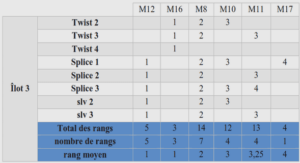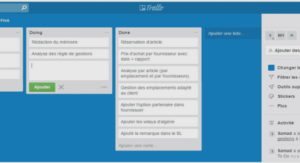Influence d’un NLTVA sur l’instabilité de flottement
L’influence d’un amortisseur non-linéaire de vibration accordée (NLTVA) sur l’instabilité de flot- tement de profil d’aile est étudié. En particulier, son effet sur le seuil de l’instabilité, l’amplitude des cycles limites se développant après le seuil d’instabilité et la potentielle sous-criticalité de la bifurcation, sont analysés. Dans cette optique, le mouvement du profil d’aile est étudié à l’aide du modèle classique à deux degrés de liberté en utilisant une approche linéaire pour l’estimation des efforts aérodynamiques. Afin d’assurer l’apparition de cycles limites dans le régime post-flottement, des non linéarités cubiques sont incluses dans le modèle structurel. L’influence de chaque paramètre du NLTVA est étudié et une règle d’optimisation de ces paramètres est proposée. L’étude révèle la capacité du NLTVA à retarder de façon conséquente le seuil de l’instabilité, ainsi qu’à assurer la super-criticalité de la bifurcation et réduire l’amplitude des cycles limites.Ce chapitre est composé d’un article écrit en anglais et soumis à la revue Journal of Computa- tional Nonlinear Dynamics. La première partie de l’article présente les équations du mouvement du système couplant le profil d’aile et le NLTVA, le deuxième chapitre s’intéresse à l’analyse de stabilité linéaire du profil d’aile à deux degrés de liberté couplé au NLTVA et la troisième partie détaille l’étude de l’influence du NLTVA dans le régime post-flottement.
Flutter control of a two-degrees-of-freedom airfoil using a nonlinear tuned vibration absorber
When slender structures, such as bridge deck or airfoil, undergo wind excitation, a flutter insta- bility, triggered by a Hopf bifurcation, may arise. The flow velocity for which the instability starts is called flutter velocity. This phenomenon is detrimental and may even lead to fatal vibrations of the structure.Numerous strategies have been investigated in the past in order to control the flutter instability. Most of them concern active control techniques, such as governing a trailing edge flap on the wing [1, 2, 3] or using piezoelectric actuators [4]. The reader may refer to the Dowell’s book on aeroe- lasticity [5] for more details on flutter active control. The alternative strategy is the use of passive control techniques, which is also the aim of the present study. This research topic is relatively recent. Most efforts have been devoted to bridge deck passive control [6, 7, 8].The most classical passive device for controlling flutter instabilities is the tuned vibration absorber initially developed by Den Hartog [9], and generally known as TMD (Tuned Mass Damper) or TVA (Tuned Vibration absorber). This device consists of a small lumped mass attached to the primary structure through a linear spring and a damper. If its eigenfrequency and damping ratio are correctly tuned, it can significantly shift the flutter speed [10]. Nevertheless, the TMD has no effect on the nonlinearities arising in the post-critical regime.Lee et al. [11, 12] proposed to use a nonlinear energy sink (NES) to control the flutter instability.
The NES has been initially investigated in the field of vibration control [13, 14, 15], it consists of an oscillator linked to the primary structure through an essential nonlinear stiffness (i.e. with no linear part), leading to targeted energy transfer [16]. Applied to the flutter control, the method shows an important reduction in the amplitude of the LCOs [11, 12]. Nevertheless, it has no effect on the flutter velocity, and needs a certain amount of energy to be activated.In the present study, the use of a nonlinear tuned vibration absorber (NLTVA), as proposed by Viguié and Kerschen [17] and Habib et al [18] is investigated. The distinctive feature of the NLTVA is that it possesses both a linear and a nonlinear stiffness. The linear part of the absorber enables to recover the optimal control given by a TMD, whereas its nonlinear part can be tuned in order to enhance the control of the primary system nonlinearities, using a so-called principle of similarity [19]. Its effectiveness has been proven on a Van der Pol-Duffing oscillator [20]. Moreover, several experimental realizations of the NLTVA have been recently explored [21, 22] and a tuning rule for the NLTVA parameters coupled with a primary system having polynomial nonlinearities has been proposed using the Den Hartog’s equal peak method [19].In the present context of the flutter instability, two main design rules are followed for optimizing the NLTVA characteristics. First, the linear stiffness of the absorber is tuned in order to increase as much as possible the critical flutter velocity, thus repelling the appearance of LCO to larger flow velocities. This step consists in finding the optimal values of a TMD in order to control the flutter instability, for which preliminary results can be found in [23] for a specific set of airfoil parameters.
Secondly, the nonlinear stiffness of the NLTVA may be tuned in order to enforce supercriticality, as well as to reduce the LCO amplitudes. The aim of the present study is thus to extend the results presented in [20], obtained for a Van der Pol-Duffing oscillator as primary structure. To get closer to a real airfoil situation, the primary structure is here selected as the classical two degrees-of-freedom aeroelastic system, with pitch and plunge motions as generalized coordinates [5]. The quasi-steady theory is used to estimate the aerodynamic loads. In order to take into account the nonlinear structural behavior for large displacements, the model includes cubic stiffness terms in the pitch and plunge motion. This allows the system to develop LCO in the post-critical regime.The first section is devoted to the linear stability analysis. The optimization of the linear char- acteristics of the vibration absorber is investigated, showing in particular how the flutter velocity can be repelled to larger values using a well-tuned absorber. The airfoil parameters are then varied and a design rule is proposed in order to find easily the optimized linear values. Then the influence of the nonlinear part of the NLTVA is investigated. Two different cases are specifically studied for the airfoil nonlinear restoring force: a hardening and a softening scenario. These results give a number of fruitful strategies in order to control passively the flutter instability by means of a nonlinear vibration absorber.



